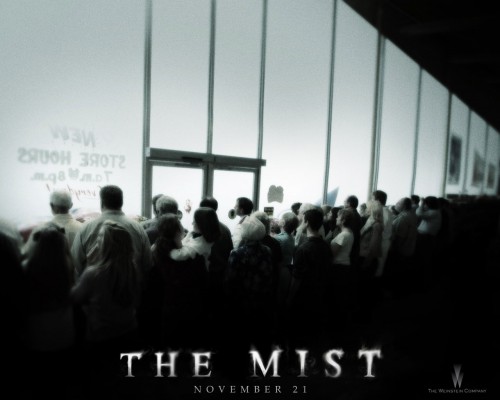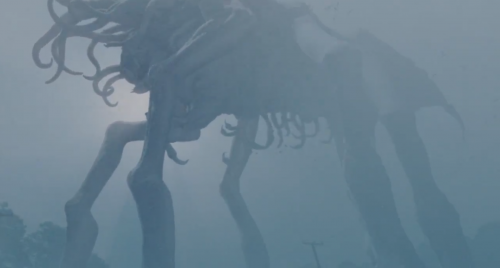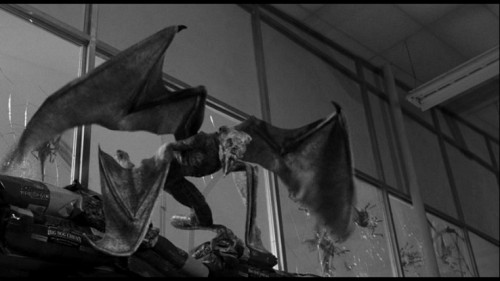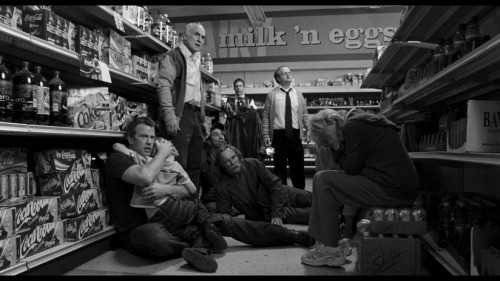
The fourth and final installment of Ian Olson & I’s Halloween series for Mbird focuses on Frank Darabont’s 2007 adaptation of a Stephen King novella, The Mist—which has been spoken about briefly before. The film stars Thomas Jane, Marcia Gay Harden & Andre Braugher.

Blake:
The Mist is a throwback 60’s style creature flick where a group of people are trapped in a grocery store surrounded by a strange, dense mist that came in after an intense storm the night before. If that was not weird enough for the poor captives, those who try to escape the store into the mist seem to be killed and devoured by something in the mist. And if the evil revealing itself amidst the dense mist is not enough, there is also the threat of violent factions forming between the captives themselves inside the store as they attempt to find explanations through human rationality or religious fanaticism. Both end up being not terribly useful and getting patrons of the supermarket killed. Whatever the mist is and whatever is living in its midst is bigger than the human ability to comprehend.
 It is no coincidence that the creatures that are seen in the film have a very Cthulhu-like look about them. Many of the CGI monsters look like they were directly inspired by the widely loved creations of H.P. Lovecraft. And those creatures take on a more ominous stature when Darabont’s director’s cut of the film is watched instead of the theatrical version. Darabont wanted The Mist to be filmed in black and white as an artistic choice and homage to earlier creature flicks of the past, but the studio turned that proposition down. However, the black and white version was released on the special edition Blu-Ray copy of the film. This is my preferred viewing experience as well, because the black and white brings out the intensity and suffocating atmosphere of the film better than the color version does.
It is no coincidence that the creatures that are seen in the film have a very Cthulhu-like look about them. Many of the CGI monsters look like they were directly inspired by the widely loved creations of H.P. Lovecraft. And those creatures take on a more ominous stature when Darabont’s director’s cut of the film is watched instead of the theatrical version. Darabont wanted The Mist to be filmed in black and white as an artistic choice and homage to earlier creature flicks of the past, but the studio turned that proposition down. However, the black and white version was released on the special edition Blu-Ray copy of the film. This is my preferred viewing experience as well, because the black and white brings out the intensity and suffocating atmosphere of the film better than the color version does.
Also, like the works of H.P. Lovecraft, the film deals with creatures and universes whose existence was ignored as mere farce. However, once the cosmos revealed itself—for no persons in the film stumbled upon its discovery—those in the store were forced to reckon with this new incomprehensible revelation. Some laughed in its face and denied its existence even when the evidence shed blood right before them. They reasoned that such things could not happen for they were not normal, let alone natural. This was the view of Brent Norton (Braugher) and those who flocked behind him. Others, like Harden’s Mrs. Carmody, sought out a much more “Old Testament”, apocryphal interpretation. With every new revealed characteristic of the mist and those beings in it, she attempted to find explanation in the book of Revelation, albeit without grace and mercy. Mrs. Carmody’s religion was one of blood and expiation—the taking away of guilt by some penalty being paid or an atonement being made.
Mrs. Carmody, however, focuses only on expiation at the expense of the propitiation—the object given to change God’s enmity toward us to his being for us. She viewed every person murdered in the mist as a sacrifice to appease God for the mean time. This goes to the point of those in her cult actively offering up one of the military servicemen to the creatures in the mist because of his guilt in the Arrowhead military conspiracy that apparently led to this event happening in the first place. Her understanding of sacrifice is merely temporal. Each sacrifice appeases God for the time being, but none can placate God’s wrath forever.
 On the ground this is probably the type of experience that characters in the Old Testament felt was true to reality, whether it was true from God’s perspective or not. And maybe the most frightening part of the film is the fact that the substance of the revelation was something that denied mercy and grace and a sacrifice that would placate the wrath forever. It does appear in the film, at several points—including one scene where a creature flies onto Mrs. Carmody and crawls up her body and looks at her and spares her life—to belabor that point. The film, from beginning to end, develops a reality and a cosmic revelation that happens in a world without Christ, without mercy and grace. Mere karmic religion: if one obeys then one is not destroyed; if one disobeys then they become the puppy chow of Lovecraftian creatures. This becomes the most apparent in the final scene of the film. A scene that the film is famous for and really drives home the end point of a cosmos that has not collided with the perfect atonement—200 proof grace—of Jesus Christ on the cross.
On the ground this is probably the type of experience that characters in the Old Testament felt was true to reality, whether it was true from God’s perspective or not. And maybe the most frightening part of the film is the fact that the substance of the revelation was something that denied mercy and grace and a sacrifice that would placate the wrath forever. It does appear in the film, at several points—including one scene where a creature flies onto Mrs. Carmody and crawls up her body and looks at her and spares her life—to belabor that point. The film, from beginning to end, develops a reality and a cosmic revelation that happens in a world without Christ, without mercy and grace. Mere karmic religion: if one obeys then one is not destroyed; if one disobeys then they become the puppy chow of Lovecraftian creatures. This becomes the most apparent in the final scene of the film. A scene that the film is famous for and really drives home the end point of a cosmos that has not collided with the perfect atonement—200 proof grace—of Jesus Christ on the cross.
The ending is about empty hope, a hope that has no object to cling unto. It is a case study of the emptiness of Camus’s famous predicament: in the midst of the absurdity of the world, one can commit suicide, believe in a (imagined) god or live courageously in the face of that absurdity. The final scenes of this film point to the truth of human experience: that no person can control themselves to live courageously in the face of the world with all of its absurdity. Either a person clings to something that gives substance to their hope or they end themselves in the face of hopelessness.
And according to this film, neither human reason nor fanatical religious observance of the law is a worthy substance of hope. Matter of fact, the film seems to say that both of those options end in death. And the mist and creatures hidden within it carry on their way in complete indifference to the humanity beneath it.
Ian:
How can I possibly expand on Blake’s exposition of The Mist? All I feel I can do is re-emphasize certain points from Blake’s analysis with extra force by construing the film as two hours of negative space that make the gospel supremely attractive. The Mist, you see, shows us that our greatest peril isn’t finally located out there somewhere- the profoundest catastrophe darkening the horizon of every human life is idolatry. Regardless of whatever ideology we profess, the choice for human beings is never, “Will I worship?” but rather, “What will I worship?” All humans without exception take their stand for some god or another. How can that be?
 Nature is a latticework of communicative channels, pouring out testimony of some divine power, echoes of those first speech-acts which set the world in motion. There’s no one alive who doesn’t catch some of these murmurs of divinity- nature’s signal registers in our bandwidth and delivers some type of content. Deity haunts the corridors of our hearts, a rumored spectral king we sense underwriting every narrative we construct. How do decipher these signals, though? And what do we attribute them to? These are the crucial questions we see being answered in The Mist.
Nature is a latticework of communicative channels, pouring out testimony of some divine power, echoes of those first speech-acts which set the world in motion. There’s no one alive who doesn’t catch some of these murmurs of divinity- nature’s signal registers in our bandwidth and delivers some type of content. Deity haunts the corridors of our hearts, a rumored spectral king we sense underwriting every narrative we construct. How do decipher these signals, though? And what do we attribute them to? These are the crucial questions we see being answered in The Mist.
Although some interpreters see Paul describing a universal consciousness of the one true God in Romans 1, it’s rather clear he’s arguing for quite the opposite: that humanity’s natural state is defiant estrangement from the Creator, that our rebellion is so pervasive, so total, we will assign these signals to anything other than the Creator. Our hatred of this God compels us to misread every intimation of power and glory in nature as an overture from some other god, a god we are more comfortable with. But exchanging the worship of the Creator for worship of some created thing only ever yields disaster.
The most chilling thing about The Mist isn’t the Lovecraftian beasts lurking on the periphery: it’s the degeneration of image bearers as battle lines form around their various gods. Mrs. Carmody and her cult vividly illustrate how somber and repulsive it is when human beings wither under the strain of idolatry. The mist phenomenon supplies Mrs. Carmody with a convenient inhuman counterpart to hang all of her God-talk upon; by contrast, it provides Norton with something to deny and reinforce his control belief. Both need an opponent to contest, but where they find it depends on their prior commitments. Either way, reality is recast in a way conducive to the narratives both characters wish to inhabit, and therein lies the key to the film’s take on worship. Whatever it is that enables us, even goads us on, to insinuate ourselves over against reality, whatever that construct is, that thing is our god. We all follow directives from some authority just beyond reach, leading us out our present state of existence. Fallen man is always and ever the prophet of the No-God, and exists and perishes in the squalor of idolatry.
 This is why the ending is so crucial, as Blake pointed out. Hope is banked on the god we confess, whatever that god may be: human rationality, progress, hedonism, aesthetics, or even anonymous, inhuman hypostases the sort of which Mrs. Carmody swears allegiance to. All these alternatives are counterfeits, unwilling and unable to rescue us from our plight; they only offer substance-less, groundless “hope”, ambiguous optimisms which cannot sustain the human soul. Nothing stands behind their promises to cash them out- all other gods will leave us empty-handed, laughing at our misery.
This is why the ending is so crucial, as Blake pointed out. Hope is banked on the god we confess, whatever that god may be: human rationality, progress, hedonism, aesthetics, or even anonymous, inhuman hypostases the sort of which Mrs. Carmody swears allegiance to. All these alternatives are counterfeits, unwilling and unable to rescue us from our plight; they only offer substance-less, groundless “hope”, ambiguous optimisms which cannot sustain the human soul. Nothing stands behind their promises to cash them out- all other gods will leave us empty-handed, laughing at our misery.
The living God, on the other hand, is the end of all the heart’s yearnings, the confluence of all our passions and ideals, the very goal of all history; He has a human face and knows human anxieties and perils and has forever surmounted them. And He is propitious: He offered Himself as an expiation once for all. He is the substance, the very bedrock of hope. Christless hope is no hope at all, only a prolonged suicide. There’s nothing courageous about soldiering through a pointless, godless universe- it’s about as heroic as strapping lead weights to your ankles and leaping off a bridge. No human being has the wherewithal to endure the absurdity. And The Mist‘s bloodcurdling climax captures that for all with eyes to see and ears to hear.
Below is the making of the film. I love listening to Darabont talk about movies. He sounds like a true fan of film.
[youtube=https://www.youtube.com/watch?v=B2NR_Wt0Zig&w=600]

COMMENTS
5 responses to ““I Can Feel It Coming in the Air Tonight, Oh Lord”: Frank Darabont’s The Mist (2007)”
Leave a Reply













The AV Club posted a great article today about why King’s horror stories have not historically translated so well to the screen, citing that the most applauded film adaptations of his books have been the dramas like THE SHAWSHANK REDEMPTION, THE GREEN MILE, and STAND BY ME. This is largely to do with the fact that those films tackle more realistic fears born in human condition. The writer went on to say that even in THE SHNNING, the most famous of film adaptation of King’s horror stories, King was severely unhappy with the results because the film portrayed Jack Torrance as an already crazy man, rather than how he was intended to be: a man who’s is slowly unraveled while the horrors of a haunted house peels back the layers on his human condition, his capacity for insanity and violence. He make the point that in the horror film genre the focus is intrinsically focused on the external fears, where Kings always has, even in his most bizarre stories, seeks to uncover the labyrinth of a persons internal fears. Out of all of the King Horror movies, The Mist probably focuses on the internal faults of man better than any other. It was confirming to see how happy King was with Frank Darabont’s adaptation. Anyways, great write up guys! I enjoyed it.
That’s a lot of words, Joe. 🙂
As far as I am concerned only Frank Darabont has truly tapped into the mind of King in his adaptations. Kubrick, Hafstrom & Reiner all made solid films in their own right, but Darabont does the best of anyone in keeping with the tone and central themes of the story while still making something that is distinctly his own.
Thanks for the comment and the encouragement, Joe! I am glad you enjoyed it!
I would go so far as to say Darabont’s ending makes the film more consistent with itself as story than even the novella. What about you, Blake?
Definitely, Ian. That was a stroke of genius on his part.
Oh, and I forgot to include de Palma in the list of directors who made decent King films.
Tone Hooper tried, but it just didn’t work (although it’s still a thousand times better than the Rob Lowe version!). ‘Salem’s Lot DEMANDS a re-remake!